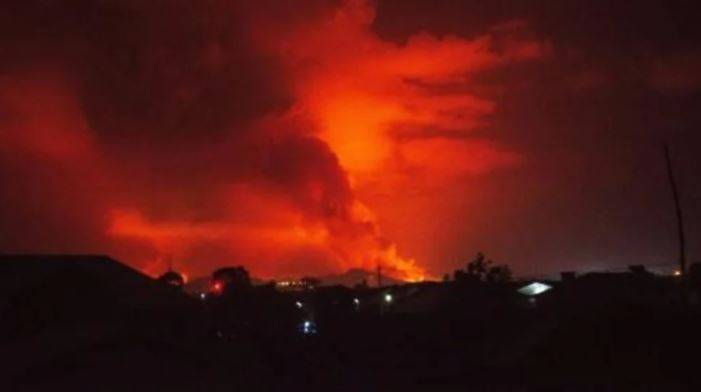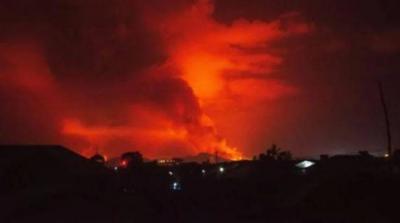The arrival of a flow of lava to the outskirts of Goma in eastern Democratic Republic of Congo, following an eruption of Mount Nyiragongo overlooking the city without prior warning, has led thousands of residents to flee in a state of panic. A spokesperson from the Virunga National Park, where the volcano is situated, reported late Saturday into Sunday that "besides the flow of lava heading northeast (towards Kibumba/Rwanda), there is a stream of lava descending into the city." He added that "this second wave of lava has reached Goma Airport and logically will flow into Lake Kivu." The airport is located in the northeastern suburb of the city, which lies between the Rwandan border and the shores of the lake. An official source did not confirm this information as the situation remained unclear late Saturday into Sunday, while residents reported that the lava flow had stopped at the airport's outskirts.
The last significant eruption of Mount Nyiragongo occurred on January 17, 2002, which resulted in the deaths of over a hundred people and completely covered the eastern part of Goma, including half of the airport's runway, with lava. The lava then slowly advanced towards the city, splitting it as it continued its path towards Lake Kivu. Unverified images from independent sources circulated on social media late Saturday into Sunday showed homes burning and being swallowed slowly by glowing molten lava in the northeastern suburbs of Goma, particularly in the Buhene neighborhood.
Mahinda Kasereka, a volcanologist at the Goma Volcanology Observatory, stated that "the lava flow is following the same path it took in 2002." The continuation of its advance into the city may be associated with the lava levels and pressure in the volcano’s crater. The sky turned red as the volcano erupted without any prior warning. A red flame erupted from the volcano's crater, and the smell of sulfur permeated Goma, situated on the southern slope of the volcano by the shores of Lake Kivu. This sudden volcanic activity immediately raised concerns among residents, who are used to the volcano's eruptions, albeit not witnessing any lava flow or feeling earthquakes.
One resident told AFP that "the sky turned red," describing "huge flames shooting out from the mountain." In a message to the residents of Goma, the largest city in North Kivu, the military governor of the region, General Constant Ndima, confirmed the eruption of the volcano. This message was followed by a government order issued after an emergency meeting held in the capital Kinshasa to "evacuate" the city.
Furthermore, Congolese President Felix Tshisekedi announced that he "decided to cut short his stay in Europe to return to the country on Sunday to oversee the coordination of assistance for the people in the threatened areas" due to the volcanic eruption. Power was cut off for a large part of the city as thousands of residents, mainly families, rushed to the nearby Rwandan border in a state of chaos, traveling on foot, by motorcycle, or in cars.
As the hours passed and the situation became increasingly dangerous, the crowd of fleeing residents swelled, carrying mattresses on their heads and packages, while children were in their arms, and vehicles honked loudly. Residents moved toward the border crossing with Rwanda in the southern part of the city or westward to Sake towards the Congolese region of Masisi. Goma is located next to the border and the "Great Barrier," which is the main border crossing between the two countries in the south of the city.
One resident who traveled with his family in a car along the Masisi road towards Sake said, "There are a lot of people on the road and many cars. It’s a mass exodus." He added, "Traffic is slow with three or four lanes of cars packed with personal belongings, carrying mattresses in their trunks or on their roofs." He continued, "There are children, women, and elderly people on foot, and it’s raining," confirming that "the situation is complicated."
Calm on the Rwandan Side
Thousands of people sought refuge late Saturday into Sunday in the border town of Rubavu (formerly Gisenyi) in Rwanda, according to a video journalist from AFP on the Rwandan side of the border. The operations are being conducted in an organized manner, with newcomers accommodated in sports fields and schools. Many are sleeping on the ground in the suburbs of the town. Rwandan ambassador to the Democratic Republic of Congo, Vincent Karega, tweeted, "The Rwandan border is open and we are welcoming our neighbors calmly."
Goma has a population of around 600,000. It is the capital of North Kivu province, which is witnessing unrest due to the presence of various armed groups. During the volcanic eruption in 2002, most of the victims were sick, elderly, or disabled individuals who were left in the northern neighborhoods of the city. Looting also occurred. A large contingent of peacekeeping forces and many staff from the United Nations mission in the country are stationed in Goma. It serves as a base for many non-governmental organizations and international organizations.
A source from a humanitarian organization stated that many staff received orders to gather at their offices or "hospitality houses." An airport source reported that several aircraft stationed at the airport, belonging to the United Nations mission or private companies, took off in the evening to evacuate the area. Goma, located near the Ugandan border, is a region of intense volcanic activity, containing six volcanoes, including Nyiragongo and Nyamuragira, which have elevations of 3470 meters and 3058 meters, respectively. The worst eruption of Nyiragongo occurred in 1977 and resulted in the deaths of over 600 people. Both volcanoes are characterized by relatively frequent "quiet eruptions," pushing lava down their slopes, as occurred in January 2002. In a report published on May 10, the Goma Volcanology Observatory had warned to "exercise caution" given the "increased... volcanic seismic activity at Nyiragongo," emphasizing it "pays special attention."




